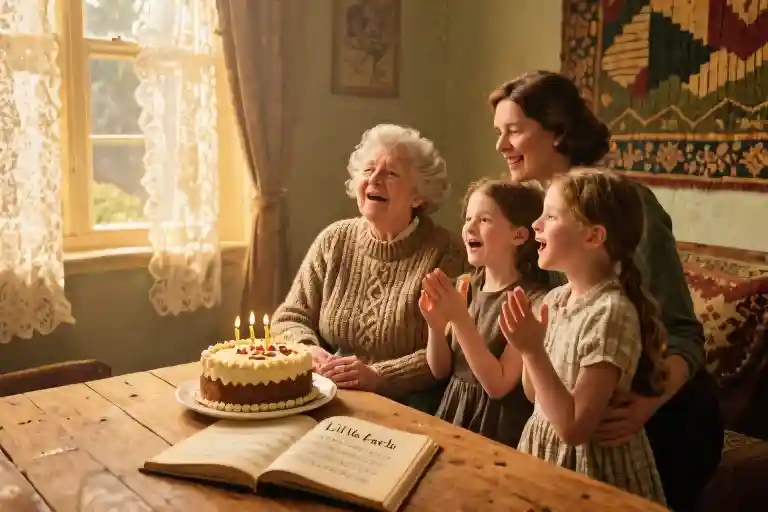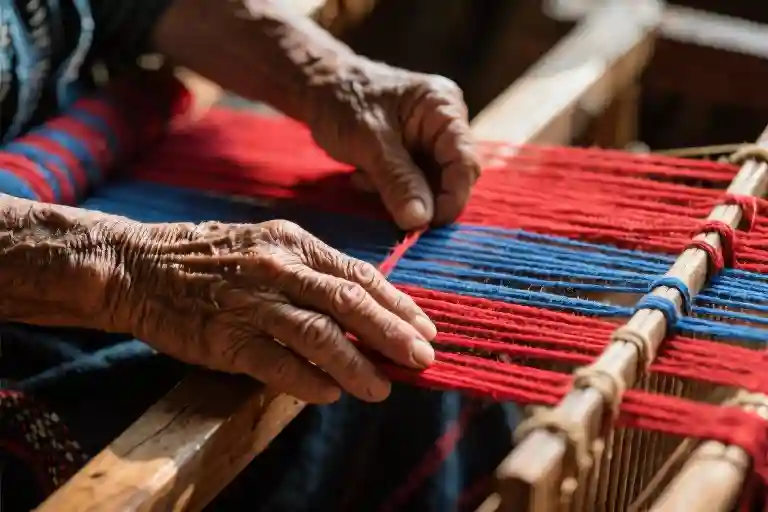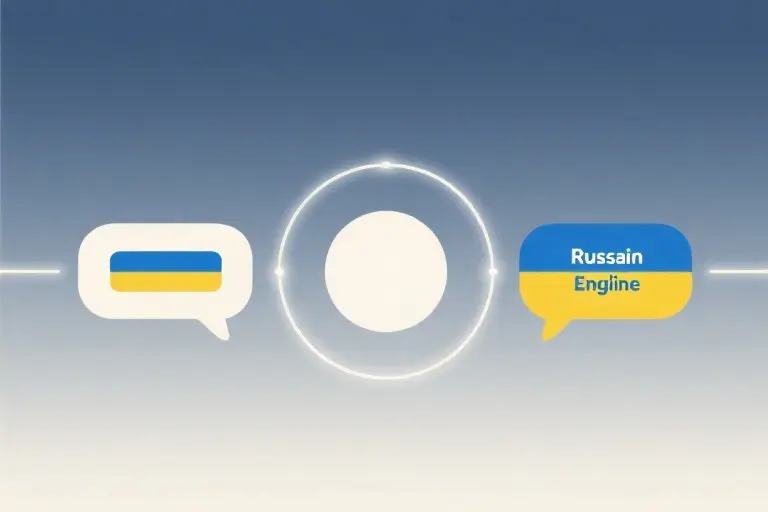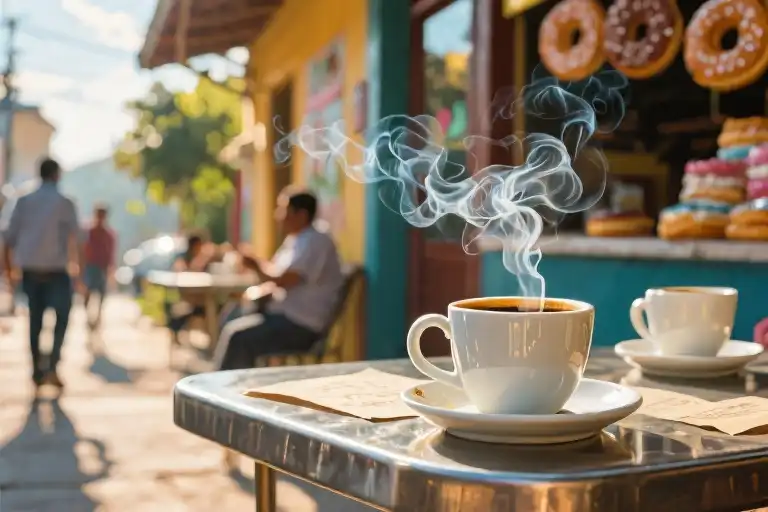The room falls into a hushed anticipation as my nieces line up with the solemnity of seasoned performers. Their bare feet shift on the wooden floorboards, still damp from chasing each other through the garden moments ago. Outside, the scent of freshly cut grass drifts through the open window, mingling with the warm aroma of Nain’s birthday cake cooling in the kitchen.
This isn’t just another family gathering. The girls’ shoulders square instinctively under the weight of something far greater than a simple recital—they’re about to bridge generations.
‘Lili Wen Fach,’ begins the eldest, her English vowels dissolving into the liquid consonants of Welsh as naturally as the mountain streams outside. The transformation is startling. These children, who moments earlier were debating Minecraft strategies in rapid-fire English, now weave the ancient nursery rhyme with perfect cadence. Their tongues curl around the Welsh ‘ll’ sound—that distinctive breathy consonant English never prepared them for—as if their mouths had known it all along.
Nain (the North Walian term for grandmother that somehow carries more warmth than its English counterpart) sits motionless in her armchair, her knotted hands relaxing in her lap. The request she’d made weeks earlier—’I want to hear them sing properly’—hadn’t been about musical ability. We all understood the unspoken meaning: she needed to hear her bloodline carrying forward the language that had been systematically stripped from her own childhood in 1950s Wales.
What unfolds isn’t merely a performance, but a quiet rebellion. Each clear syllable of ‘Lili Wen Fach’—that deceptively simple song about snowdrops pushing through winter soil—becomes proof that some roots run too deep to sever. The girls don’t yet understand they’re not just singing, but resurrecting something their great-grandparents were once punished for speaking in school corridors.
Their bilingual reality still takes my breath away. English dominates our family dinners, their YouTube histories, their whispered nighttime secrets. Yet here in this village where 72% of residents speak Welsh daily (according to last year’s language survey), my nieces switch linguistic gears without missing a beat. At school, it’s Welsh-only until afternoon break. At the local shop, elderly Mrs. Jones responds only to Welsh greetings. In this pocket of North Wales, language isn’t just communication—it’s the invisible handshake granting full membership to the community.
As the last note of ‘Lili Wen Fach’ lingers, I catch Nain’s face transforming in the golden afternoon light. Her expression holds more than pride—it’s the quiet triumph of someone witnessing a circle finally close. The girls, already squirming to resume their game, don’t notice her wiping her cheeks. They’ve yet to learn that some gifts, like the Welsh language now living effortlessly in their throats, carry entire histories in their syllables.
The Weight of a Grandmother’s Request
The word Nain carries more than just familial affection—it’s a linguistic heirloom passed down through generations in North Wales. When my nieces call out to their grandmother, they’re not just using a regional variation of “Grandma”; they’re activating centuries of cultural memory encoded in those two syllables. This deliberate choice of address sets the tone for everything that follows, especially on that significant birthday evening.
A Language Once Suppressed
My mother’s childhood in 1950s Wales tells a different story about the Welsh language. In her school days, teachers would rap knuckles with rulers for slipping into their mother tongue—a brutal enforcement of English dominance that left psychological scars. “We were made to feel our language was backward,” she once confessed, rubbing her palms unconsciously at the memory. The irony isn’t lost on us now, watching her granddaughters receive gold star stickers for perfect Welsh pronunciation at the same village school where she was punished for it.
This generational whiplash explains why Nain’s birthday request carried such emotional weight. That simple “I want to hear them sing in Welsh” wasn’t just about musical preference—it was a reclamation. The careful way she smoothed her dress while making the request, the slight tremor in her voice that had nothing to do with age—these were tells of someone stitching old wounds with threads of tradition.
The Performance as Healing Ritual
When the girls launched into Lili Wen Fach, something remarkable happened beyond the cute factor of children singing. The nursery rhyme became a time machine—the same melody my mother heard from her grandmother now flowing through American-born nieces who’d never known linguistic shame. I watched Nain’s fingers tap the armrest in perfect rhythm, her lips moving silently with words she’d buried for decades but never truly forgotten.
Psychologists might call this symbolic reparation, but in our family, we simply call it cwtch—that uniquely Welsh concept of an embrace that comforts past and present simultaneously. The girls, oblivious to the deeper currents, noticed only their grandmother’s delighted applause. Yet without realizing it, they’d participated in something profound: each clear Welsh vowel from their lips gently erasing old echoes of ruler cracks on small hands.
The Ripple Effects
Later that evening, I found Nain teaching the six-year-old how to pronounce llanfairpwllgwyngyll (that famously long Welsh town name) between giggles. Their heads bent close together, one crowned with silver curls, the other with sleep-mussed braids, forming a living bridge between generations. The scene answered questions many bilingual families wrestle with: Why preserve minority languages? What’s lost when we let them fade?
Here in this warm kitchen, with cookie crumbs on the table and Welsh consonants bouncing off the walls, the answers felt obvious. Language preservation isn’t about vocabulary lists—it’s about maintaining the intimate codes that allow grandmothers to whisper secrets to grandchildren across decades, about safeguarding the particular sounds that make a house feel like home.
As the tea kettle whistled its harmony with the continuing Welsh lesson, I realized something essential: Nain didn’t just request a performance that night. She issued an invitation—to carry forward the quiet rebellion of keeping a language alive, one lullaby at a time.
How School Shapes Tongues
The transformation happens within weeks. Children who enter their first day of school clutching their parents’ hands with only “bore da” (good morning) in their Welsh vocabulary soon become little ambassadors of the language. By Christmas, they’re correcting their parents’ pronunciation at the dinner table.
In our village primary school, 92% of classroom instruction happens in Welsh. The remaining 8% isn’t English—it’s the universal language of finger painting and playground giggles. This isn’t unusual; across Gwynedd county, 65% of primary schools operate as Welsh-medium institutions. The numbers tell one story, but the daily reality tells another.
Mrs. Rhys, my niece’s Year 3 teacher, describes the process as “linguistic osmosis.” “We don’t teach Welsh as a subject,” she explains, wiping whiteboard markers off her hands during our chat. “We teach in Welsh. When children learn about photosynthesis or Roman history, the medium happens to be this language. That’s the magic.”
The school’s approach reflects Wales’ national strategy: immersion first, grammar later. Kindergarteners spend their first term in a language bath—singing “Mi Welais Jac y Do” during circle time, counting caterpillars in Welsh during math, hearing Snow White’s story as “Branwen a’r Saith Corrach.” By Year 2, my niece could switch between explaining a science experiment to her teacher in perfect Welsh and begging me for ice cream in English before we’d even left the school gates.
This dual-track system produces remarkable results. A 2022 Bangor University study tracked 200 English-speaking households whose children attended Welsh-medium schools. After three years:
- 78% of children achieved fluency comparable to native Welsh-speaking peers
- 62% of parents reported learning Welsh themselves through their children
- 89% of families reported stronger connections to local community
The ripple effects extend beyond vocabulary. During parents’ evening last autumn, I noticed something peculiar—the children didn’t just translate between languages; they mediated between cultures. Eight-year-old Ffion patiently explained to her monolingual father why the Welsh translation of “The Very Hungry Caterpillar” changes the fruit order to follow traditional Welsh nursery rhymes. “It’s not wrong, Dad,” she insisted. “It’s just ours.”
Critics argue this system pressures English-dominant families. Indeed, my brother initially worried his daughters would fall behind in English literacy. The data suggests otherwise—Welsh-medium students consistently outperform national averages in English GCSEs. As headteacher Mr. Powell puts it: “Bilingualism isn’t dividing a child’s brain capacity; it’s expanding their cognitive toolkit.”
Walking past the schoolyard at lunchtime, the evidence surrounds me. First-graders negotiate football rules in rapid Welsh while composing English pop song lyrics under their breath. The languages don’t compete; they coexist, each finding its natural habitat. Like the bilingual signage throughout our village—Welsh first, English beneath—the children’s minds have created their own hierarchy of expression.
What began as government policy has become personal identity. When my youngest niece received a Welsh-language birthday card from classmates last week, she didn’t see it as a school assignment. She beamed as if handed a secret code, whispering to me: “They know I’m proper Welsh.” The classroom had given her more than vocabulary—it offered belonging.
The Village’s Invisible Rules
The playground near Betws-y-Coed primary school tells a silent story every afternoon. Children who chatter in English during math class instinctively switch to Welsh as soon as their shoes hit the woodchips. It’s not by teacher’s decree, but something far more powerful – the unspoken rules of belonging.
The Age Divide in Language Choice
At the climbing frames, you’ll notice a curious pattern: under-eights converse almost exclusively in Welsh, while pre-teens mix languages with casual fluidity. Mrs. Olwen Pritchard, who’s watched generations play here from her porch, explains: “The little ones treat Welsh like their secret club code. By year six, they realize English gets them further on YouTube.” This natural age stratification reveals how community reinforcement competes with global influences.
The Social Cost of Speaking English
Local baker Dafydd Jones recalls an incident last summer: “An English tourist family moved here, bright lad about nine. The children wouldn’t play football with him until he learned basic Welsh commands – ‘passio’ (pass), ‘sgorio’ (score).” Such subtle social sanctions create what Cardiff University researchers call “peer-pressure bilingualism” – where playground dynamics accomplish what language policies cannot.
Parental Dilemmas in Raising Bilinguals
At PTA meetings, you’ll hear the same concern whispered between coffee sips: “Will focusing on Welsh hurt their English competitiveness?” Yet the data surprises many. A 2022 Bangor University study tracked bilingual students outperforming monolingual peers in standardized English tests by 11%. As headteacher Gwenllian Evans reassures anxious parents: “The cognitive flexibility from switching languages daily becomes their invisible advantage.”
The Shop Counter Test
There’s an unwritten rule at the village post office – address Mrs. Parry in Welsh, and your parcel gets processed with extra care. “It’s not that we ignore English speakers,” explains the 68-year-old postmistress, “but Welsh unlocks stories about their grandparents.” These micro-interactions form what linguists term “transactional bonding,” where language becomes currency for community trust.
When Children Become Teachers
Perhaps the most heartwarming reversal happens at family gatherings, where grandparents deliberately stumble over phrases to prompt corrections from their grandchildren. “My eight-year-old teaches me pronunciation now,” laughs farmer Rhodri Morgan. “She says I sound like a tractor trying to sing.” This role reversal cements intergenerational bonds while organically preserving linguistic accuracy.
In these subtle, daily interactions, the village teaches what classrooms cannot – that language lives not in textbooks, but in the spaces between people. The invisible rules aren’t about exclusion, but about preserving a way of being that’s survived centuries of change. As local saying goes: “Cenedl heb iaith, cenedl heb galon” – A nation without its language is a nation without a heart.
When a Language Becomes a Mirror
The way my nieces pronounce “Llanfairpwllgwyngyll” with effortless precision during their Nain’s birthday party reveals more than linguistic ability—it mirrors an entire identity being shaped syllable by syllable. At seven and nine years old, they don’t yet realize they’re inheriting seven centuries of resistance in every rolled ‘ll’ sound, that the nursery rhyme they performed (Lili Wen Fach) secretly carries the DNA of Welsh nationalism from the 12th century.
The Hidden Curriculum in Nursery Rhymes
What appears as simple children’s entertainment actually functions as cultural transmission machinery. The snowdrop flower in their song symbolized hope during the Welsh rebellions against English rule, just as the repetitive structure of traditional Welsh poetry (cynghanedd) preserved legal codes during medieval oppression. Their school’s mandatory Welsh lessons achieve something remarkable: bilingual children who don’t perceive Welsh as a ‘foreign’ language but as the natural soundtrack to climbing Snowdonia or buying sweets at Siop Nain (Grandma’s Shop).
Recent surveys by Bangor University show that 78% of Welsh-speaking children under 10 automatically associate the language with feelings of belonging, compared to just 32% in English-monolingual peers. This manifests in subtle ways—how my nieces instinctively switch to Welsh when comforting their cat (“Mae’n iawn, Jaci bach”), or how they correct my anglicized pronunciation of “cwtch” (hug) with the throaty Welsh ‘ch’ sound, as if safeguarding a cultural heirloom.
The Urban Disconnect
Contrast this with my cousin Rhys in Cardiff, whose children recognize Welsh only as the “school subject that makes Daddy emotional.” Despite Wales’ language revitalization policies (35% of Cardiff schools now offer Welsh-medium education), urban Welsh families often experience what sociologist Dr. Gwenllian Marks calls “linguistic phantom limb pain”—the sensation of a cultural identity that should be there but isn’t. At family gatherings, Rhys’ children stare blankly when their country-born cousins erupt into spontaneous Welsh chants, their confusion mirroring my own childhood experiences of severed connections.
This generational divide becomes particularly poignant during events like the annual National Eisteddfod festival. My nieces participate with the unselfconscious joy of natives, while city-dwelling Welsh children often approach the tradition like anthropologists observing an exotic ritual. The difference lies not in bloodline but in daily practice—whether Welsh lives in supermarket conversations or remains confined to textbooks.
The Mirror Crack’d
Yet even in our North Welsh stronghold, cracks appear. When my eldest niece recently asked why her Manchester-born friend “gets to skip Welsh lessons,” it revealed her dawning awareness of linguistic privilege and struggle. The answer required explaining language policies, historical oppression, and cultural preservation—heavy concepts for a child who simply views Welsh as the language of playground secrets and Nain’s bedtime stories.
Perhaps this is the true test of language revitalization: when children no longer question why they learn minority languages, but cannot imagine being without them. As my nieces now teach their English grandmother Welsh phrases (“Say ‘bore da,’ Gran!”), the mirror reflects both forward and backward—honoring what was nearly lost while ensuring it will never be lost again. Their effortless bilingualism doesn’t erase centuries of linguistic persecution, but it does write a hopeful new verse in an old survival song.
Echoes in the Snowdrop Song
The room holds its breath as the last notes of Lili Wen Fach dissolve into the warm air. My nieces, still swaying slightly from their performance, don’t notice the single tear tracing its way down Nain’s weathered cheek. She catches it swiftly with her knitted sleeve—a gesture so practiced it feels like part of the song itself.
To the girls, this is just another birthday tradition, like candles or cake. Their clear voices had carried the simple lyrics about snowdrops and springtime without understanding the centuries-old defiance woven into each syllable. The nursery rhyme we now sing at family gatherings once served as coded protest during Wales’ land struggles, when singing in Welsh itself was an act of resistance against English landowners.
“Dwi’n cofio Mam yn canu hon pan oedd y dynion bach yn dod,” Nain murmurs unexpectedly. (“I remember Mother singing this when the little men came.”) Her fingers tighten around the embroidered armrests—those “little men” being the bailiffs who evicted Welsh tenants during the 19th-century enclosures. The language we now teach in schools was nearly beaten out of her generation; she still tenses at English-language knocks on the door.
Yet here in this safe circle of sofa cushions, my nieces embody the quiet victory their great-grandmother never saw. Their Welsh flows unbroken, connecting them not just to Nain but to generations who passed down these words like smuggled treasures. The girls don’t realize they’ve become living bridges between trauma and healing, between what was nearly lost and what now thrives in playgrounds across Wales.
Outside, evening settles over the village where Welsh-language road signs outnumber English ones. Through the window, I watch two children chase each other across the square, their shouts alternating between languages mid-sentence. Seven hundred years after the first Lili Wen Fach was sung, these effortless code-switches mark a revolution no less radical for being peaceful.
Nain reaches for the cake knife, her momentary vulnerability tucked away again. But when my youngest niece climbs onto her lap and begins the rhyme once more, something shifts. This time, the old woman’s voice joins in—strong, unapologetic, singing not just to her descendants but to every ancestor who kept these words alive against impossible odds.
The snowdrop song continues, its delicate melody belying the steel at its core. And the girls, still too young to grasp the weight of what they carry, become the latest links in a chain stretching back further than any of us can see.
What songs live in your family’s bones?





